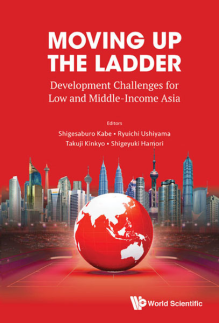
Books by Kobe LADS members

This book explores (1) the current state of Asian economies and 2) the conditions or policy counter-measures that lead to higher income levels under changing external circumstances. This is illustrated through case studies on five Asian economies, with emphasis on their structural problems. It also aims to paint a comprehensive picture of necessary policies, which will encourage Asian countries to move up the ladder of growth.
.png)
.png)
This book studies some important issues in China’s labor market, such as rural labor migration, employment and wage discrimination, the new dual labor market, and economic returns on schooling, using the newer and representative data and advanced estimation models. This approach has yielded many interesting results, including a solution to the dilemma of two ongoing crises since 2004: the rural labor surplus and severe shortage of migrant labor. While male workers generally received less favorable treatment and consequently enjoyed a lower average employment probability than female workers in 1996, they also received preferential treatment over female workers, who otherwise had identical worker characteristics in 2005. We provide new estimates for male-female hourly wage differentials in urban China, and our results indicate that the hourly wage differentials and the unexplained part of the hourly wage differentials are smaller than the differentials obtained by ignoring the sample selection bias. We study China’s new dual labor market, which is shifting from a rural migration versus urban workers setup to informal workers versus formal workers setup, and present some interesting results. Our study is the first to adopt the IV methodology and the Heckman (1979) two-step procedure simultaneously for the estimation of economic returns on schooling in China.
With increased resilience in the financial systems, emerging Asian economies were less affected by the recent global financial crisis, recovering more quickly from the crisis than major advanced economies. Yet, Asian financial systems remain underdeveloped. More open and efficient financial systems continue to be a key priority for Asia’s development strategy. Emerging Asian economies need to tackle the new challenges to macroeconomic and financial stability posed by financial globalization. This book identifies the key challenges to Asia’s financial development in an era of rapid financial globalization and discusses their policy implications for financial reforms and regional cooperation in East Asia. Particular areas of focus include: the impact of financial globalization on economic stability and inequality in East Asian economies; the progress of Asia’s regional financial cooperation and lessons from the recent European economic crisis; and the priority of financial reforms in individual Asian economies. Combining advanced econometric methods and in-depth case studies, this book provides rigorous and contextual analyses of the most critical issues for Asia’s financial development. It offers a comprehensive and useful guide for students, academics, and policymakers interested in the current state and future prospects of Asian financial systems.
- Kinkyo, T., Matsubayashi, Y. and Hamori, S. ed. (2013) Global Linkages and Economic Rebalancing in East Asia (World Scientific)
In the wake of the global financial crisis, leading industrialized countries
have managed to show only a gradual recovery, while East Asian economies
have surged ahead. In particular, China achieved growth in excess of 10
per cent in 2010 and is expected to continue growing at a rapid pace. It
appears that in the coming years, East Asia will play an even greater role
as a growth center leading global economic expansion. Following the Asian
currency crisis of 1997 - 98, consumption and investment in the region
decreased considerably, and East Asian economies recovered on the strength
of exports. Presently, however, amid a less-than-robust recovery in the
US and Europe, the sustainability of East Asia's reliance on export-led
growth has been called into question. The region's transition to growth
based on a balance of foreign and domestic demand is important for both
building a stronger foundation for sustainable growth and buttressing global
economic expansion. Moreover, the rebalancing of demand in East Asia holds
the key to rectifying global current account imbalances - the disadvantage
of uneven international capital flows. This unique volume illuminates policy
issues involved in the efforts to promote the rebalancing of demand in
East Asia.
1.jpg)
1.jpg)
2.jpg)
2.jpg)